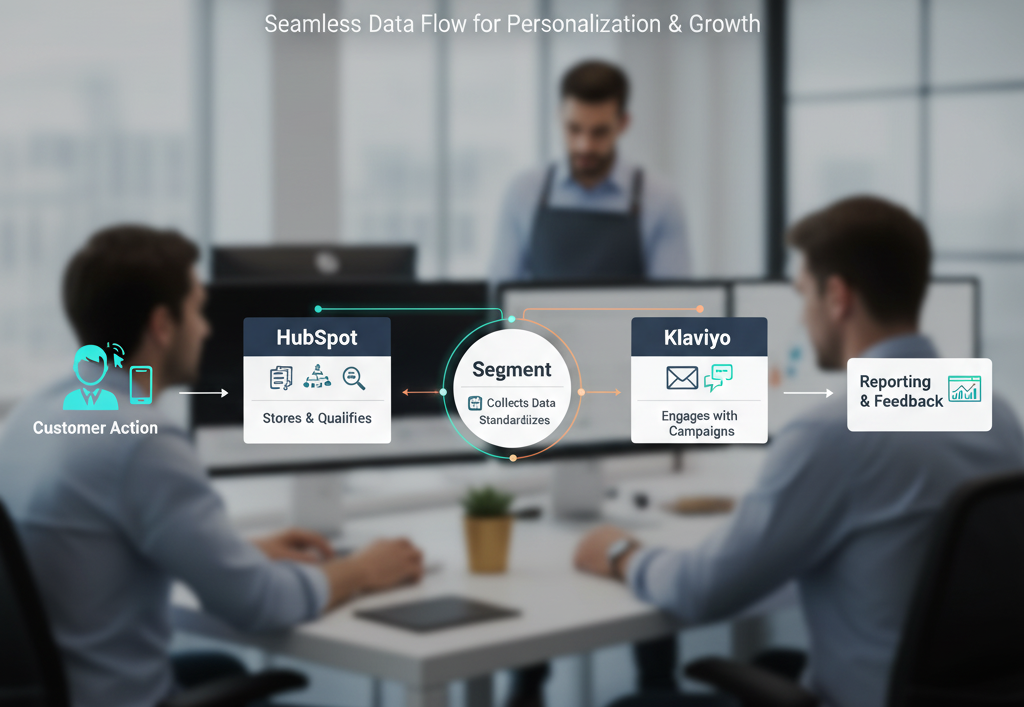
The 2025 Martech Stack: HubSpot, Klaviyo & Segment Integration
Building a Cohesive Martech Stack in 2025
Modern organizations face a constant challenge in making marketing systems work together. Data flows from multiple sources, customer expectations keep rising, and teams cannot afford inefficiency. In this setting, the Martech stack has become central to product management and long-term planning. Among the many options available, three tools stand out: HubSpot, Klaviyo, and Segment. When combined correctly, they give marketing and product leaders a clear view of their customers while ensuring campaigns are both personal and timely.
Why Integration Matters
Using HubSpot, Klaviyo, or Segment in isolation has value, but the real advantage comes from integration. HubSpot manages customer relationships and inbound activity. Klaviyo delivers powerful automation for email and SMS campaigns. Segment acts as the data pipeline, collecting, cleaning, and distributing information across the stack. Without integration, data silos develop, teams duplicate effort, and decision-making slows down. With integration, customer journeys become clear, reporting improves, and campaigns run with precision.
Core Role of HubSpot
HubSpot continues to serve as a reliable foundation for customer relationship management. It captures leads, organizes contacts, and enables sales pipelines to function without confusion. For product managers, HubSpot gives visibility into how users first interact with a business, whether through a form submission, a website visit, or a campaign touchpoint. This level of detail informs product roadmaps and helps teams prioritize features.
Strength of Klaviyo
Klaviyo is widely used for lifecycle marketing. Its ability to create targeted automations allows teams to deliver the right message at the right time. A customer who abandons a cart can be reminded within hours. A loyal user can receive personalized offers that reflect past behavior. Klaviyo’s analytics also make it clear which messages work and which need adjustment. For product management, this insight shows how communication affects adoption and engagement.
Function of Segment
Segment operates in the background but has a central role. It collects data from websites, mobile apps, and third-party tools, then standardizes it for distribution. Instead of setting up separate integrations for every platform, Segment acts as the hub. This ensures that the same customer record flows through HubSpot and Klaviyo without conflict. With Segment in place, marketing teams can trust that data is accurate, consistent, and ready for use.
Case Reference: Product Siddha’s Approach
Product Siddha has guided organizations in building unified Martech stacks where these three platforms work together. One example involved a retail company that struggled with fragmented data. HubSpot was tracking sales leads, Klaviyo was managing email campaigns, and the analytics team was pulling reports manually from multiple systems. By introducing Segment as the central connector, Product Siddha created a single source of truth. Data flowed cleanly between platforms, reducing manual reporting and giving managers a clearer view of customer behavior. The change not only improved campaign accuracy but also helped product teams understand how engagement translated to long-term retention.
Step-by-Step Integration Framework
- Define Objectives
Begin with clear goals. Decide whether the focus is on lead conversion, customer retention, or improved analytics. - Establish Data Flow
Map how information should move between HubSpot, Klaviyo, and Segment. Typically, Segment collects the raw data, HubSpot manages lead and contact details, and Klaviyo activates the communication layer. - Set Event Tracking
Configure Segment to capture critical events such as sign-ups, purchases, or feature use. These events feed both HubSpot and Klaviyo, giving consistent visibility. - Align Marketing Automations
Create Klaviyo flows that respond to Segment events and use HubSpot insights for audience segmentation. For example, a lead marked as “high intent” in HubSpot can trigger a Klaviyo sequence. - Test and Refine
Run pilot campaigns to ensure data sync works correctly. Adjust automation rules to avoid duplication or missed opportunities.
MarTech Stack Workflow
[Customer Action] → [Segment Collects Data] → [HubSpot Stores & Qualifies] → [Klaviyo Engages with Campaigns] → [Reporting & Feedback]
This linear flow makes clear how the three systems complement each other when properly aligned.
Practical Benefits for Product Management
Integrating HubSpot, Klaviyo, and Segment produces several outcomes directly relevant to product managers:
- Unified Customer Profiles – Every action, from signup to purchase, feeds into a single record.
- Improved Campaign Precision – Targeting rules rely on accurate data instead of outdated lists.
- Faster Roadmap Decisions – Data on customer behavior helps prioritize product features with real evidence.
- Resource Efficiency – Reduced manual reporting saves time and avoids errors.
Common Challenges and How to Overcome Them
- Data Duplication
If mapping rules are unclear, the same customer may appear in multiple forms. This can be avoided by carefully defining a primary identifier. - Team Alignment
Marketing, sales, and product functions must agree on event definitions. Without agreement, reporting becomes fragmented. - Platform Updates
Tools evolve, and integrations may break. Regular monitoring ensures the stack continues to function smoothly.
Product Siddha emphasizes structured governance to prevent these issues. By setting clear rules for ownership and updates, organizations maintain long-term value from their Martech investment.
Looking Forward to 2025
The Martech landscape continues to expand, but integration remains the defining challenge. Tools will keep improving, but without a coherent framework, teams risk inefficiency. HubSpot, Klaviyo, and Segment form a strong core that balances relationship management, communication, and data accuracy. For companies investing in growth, building a seamless connection between them is less a choice and more a necessity. Product Siddha continues to refine methods that ensure integration does not become a burden but a competitive advantage.
Final Thoughts
The success of a Martech stack depends on how well its parts work together. In 2025, HubSpot, Klaviyo, and Segment stand out not only for their individual strengths but for the synergy they create. When aligned, they give marketing and product teams clarity, efficiency, and confidence in decision-making. Product Siddha’s consulting experience shows that integration, once achieved, becomes a foundation for long-term product and customer success.
